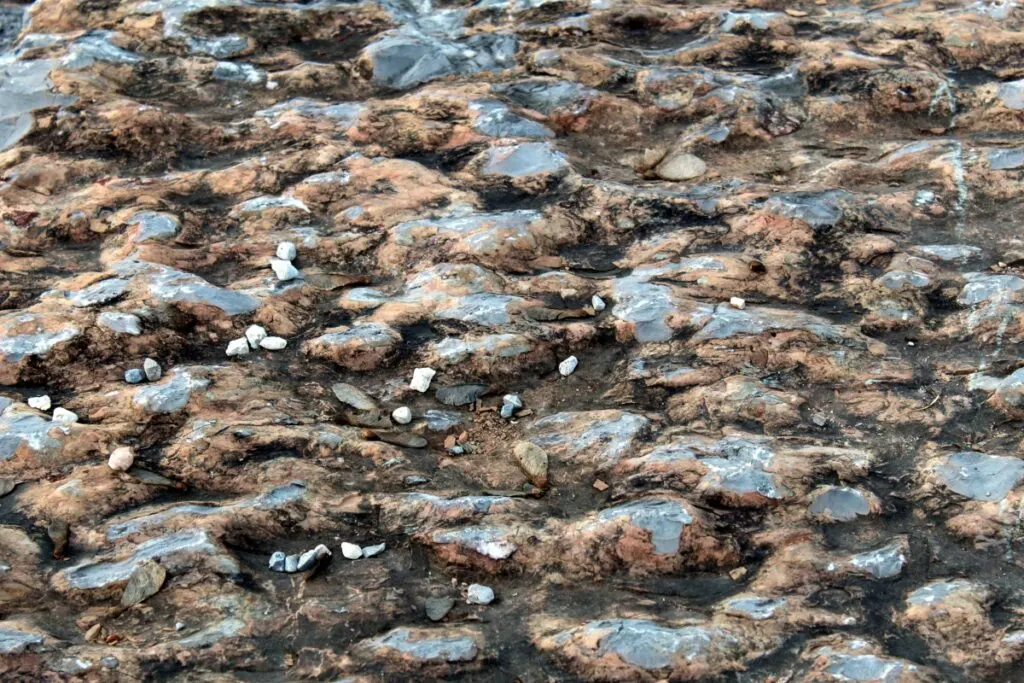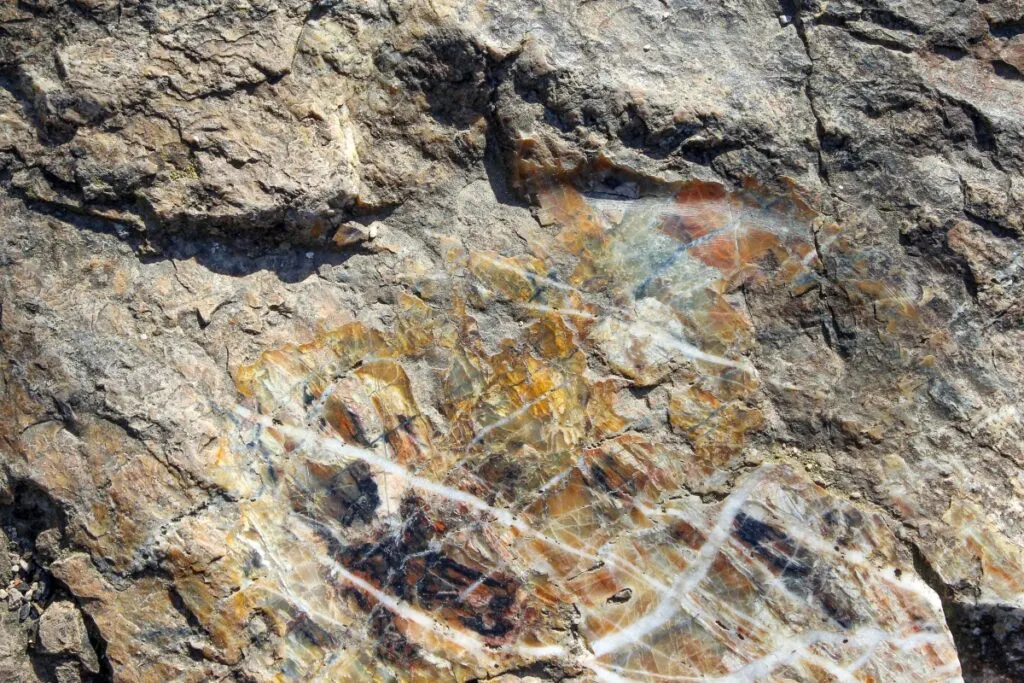As an Amazon Associate, I earn from qualifying purchases with no additional costs for you.
Chert is among the most common but popular sedimentary rocks in the world. It is made out of microcrystalline quartz, which contributes to its excellent hardness on the Mohs scale and comes in almost every color but is usually red, brown, gray, or green.
Chert is often confused with flint, which is a higher-grade material that was commonly used in the creation of tools such as arrowheads or knives. However, flint is a variety of chert. Some U.S. states where you can find common chert include Missouri, Pennsylvania, and Florida. It is often discovered interbedded with shale and limestone.
Let’s see exactly how chert forms, where you can find it, and what state is the best for finding chert specimens!

If you want to check out the best rock and mineral identification books, you can find them here (Amazon link).
Where to Find Chert Rocks Near Me (Most Common Environments)
Chert forms in various ways, but the most common method occurs through biochemical means. Marine plankton siliceous skeletons dissolve during a process known as diagenesis, and as silica precipitates from the process, chert rocks are formed.
Areas with a rich history of volcanism also result in chert formations, while chert can also form near hot springs or banded iron formations. Chert is also often found interbedded with shale or limestone. Other typical environments to find chert include gravels, beaches, mines, quarries, road cuts, exposures, streams, and creek beds.
Let’s explore some of these mediums and see exactly why you can find chert there.
If you want to check out the best rock and mineral identification books, you can find them here (Amazon link).
Quarries and Mines
Since chert is a relatively common rock, quarries, pits, and mines are some of the best environments to find. Regions with a rich history of volcanism are more prone to have chert deposits than others.
Beaches, Creeks, Streams, Washes, and Draws
Tiny silica fossils significantly contributed to the formation of chert rocks, especially those at the bottom of the ocean. In such formations, shale is also commonly discovered.
Because of this, beaches are also among the best environments to find chert specimens. Gravels, creeks, streams, washes, and draws are potentially significant areas to discover various types of chert.
BTW: Do you want to know more about rock and mineral identification? The books listed below are the best ones you can find on the internet (Amazon links):
- Smithsonian Handbooks: Rocks & Minerals
- Gemstone & Crystal Properties (Quick Study Home)
- Ultimate Explorer Field Guide: Rocks and Minerals (National Geographic Kids)
Road Cuts, Exposures, and Outcrops
Road cuts, outcrops, or exposures are other fantastic mediums to discover chert rocks. If you ever find a limestone exposure, it’s almost guaranteed that you will also find chert specimens since it forms there as nodules.
TIP: Sedimentary and igneous rocks are among the basic types of rocks. Check out the main differences between these rock types in the article below:
Sedimentary vs. Igneous Rocks: Differences & Similarities
Where Can I Find Chert Rocks in the USA? The Best Locations

As you can see, there are many environments where you can find chert specimens. If you want to go hunting for chert in the U.S., it’s essential to keep the environments mentioned in mind and that some states are more abundant in this type of sedimentary rock than others.
The best states in the U.S. to find chert include Florida, Missouri, Pennsylvania, Virginia, Wyoming, Kentucky, Oklahoma, Iowa, Tennessee, Utah, Nevada, Georgia, New Mexico, Washington, Ohio, Oregon, Michigan, and California, among others.
| State | Locations |
|---|---|
| Missouri | Bee Bluff, Greenfield, Hermitage |
| Florida | Alachua County, Marion County, Sumter County |
| California | Coyote Point, Morgan Hill, New Almaden |
Although no U.S. state has chert as its official state rock, some states have designated other varieties of chert as their official state rocks.
For example, Ohio has flint as its official state rock, while Missouri designated mozarkite as its official state rock, which is also a variety of chert. Let’s explore some of the states mentioned earlier and see exactly where you can find chert specimens!
Missouri
Missouri is probably the best state in the U.S. to find chert specimens due to its abundance here. Missouri’s official state rock is Mozarkite from 1967, a type of chert rock.
Let’s begin by analyzing the northeastern parts of Missouri! Here, chert nodules in limestone deposits at Saint Charles Quarry. Southwestern Missouri is generally the most abundant in chert specimens, especially the mozarkite variant.
Mozarkite chert can be found in quarries and gravel pits surrounding Lincoln or at Warsaw in the general area in the low hills west of Ozark Uplift. Regular chert can be easily discovered at Greenfield in virtually all gravel areas and exposures.
Gemmy chert specimens are present at Hermitage regarding road cuts and creek banks. If you want beautiful gem-quality blue chert specimens, head to Elk River near Bee Bluff.
Another important place is the area around Timber Knob. Here you can also find gem-quality chert specimens with yellow bands.
In Southeastern Missouri, you can find large gem-quality chert nodules at Current River, near Doniphan, or gem-quality flint specimens at Doniphan, the area surfaces to the east.
Regular chert specimens can also be unearthed in all the gravels and streams south of Dexter or in mining dumps around Old Mines. If you visit Missouri, try your luck to find mozarkite chert, as it is unique and will make a beautiful addition to any rockhounds collection.
TIP: For a complete rockhounding guide in Missouri, check out this article.
Florida
Florida is similarly abundant in chert rocks and varieties like Missouri. Here, you can find red fossiliferous chert in streams and creek beds at Cottondale.
All the quarries in Jackson County have chert, while you can also find the sedimentary rock along with flint specimens in stream banks, road cuts, and quarries around Washington County.
Chipley is another area where plenty of limestone exposures are present, among road cuts and other environments where you can commonly find chert.
In the northern parts of Florida, there are various locations where you can find gemmy chert. The three counties you should visit here are Marion County, Alachua County, and Sumter County.
These counties have regional limonite quarries, plenty of road cuts, and exposures where gemmy chert specimens can be unearthed, as well as fossilized ivory.
In the central regions of Florida, you can find chert in quarries, road cuts, and exposures near Bradford County. You can also search the site of limestone quarry seams near Crystal River.
The gulf beaches in Pinellas & Hillsborough Counties are also filled with chert specimens and are worth visiting.
TIP: For a complete rockhounding guide in Florida, check out this article.
Michigan
If you live or plan to visit Michigan, you should see the Keweenaw Peninsula to find some fantastic chert specimens. You can easily find chert and jasper at the Beeches north of Ahmeek.
At Keweenaw Point, you can find chert at the local beach gravels or search the beaches around McClain State Park. Some other essential beaches where you can easily find chert here are those near Lake Superior.
TIP: For a complete rockhounding guide in Michigan, check out this article.
California
California is another great state if you wish to find chert specimens. San Francisco, for example, has two great locations. You can visit Coyote Point and search for chert north of the yacht harbor or head to the outcrop only one-mile northeast of Cliff House.
San Jose also has two great chert locations. The creeks northwest of Morgan hill are abundant in chert specimens, but you can also try your luck at the area mines near New Almaden. In Kern County, you can find chert in the southeast foothills of Castle Butte.
TIP: For a complete rockhounding guide in California, check out this article.
New Mexico
New Mexico has various chert varieties you can find if you know where to look. In the northwestern parts of the state, you can find regular chert specimens in the northern area of Pedernal Park.
Gem-quality chert specimens can be found at La Madera, about one or two miles to the southeast if you want to find both chert and jasper specimens, head to Turquoise Hill and explore the surrounding area.
Southwestern New Mexico generally holds more locations to find chert than other parts of the state. The western slopes of Mimbres Mountains are filled with chert, but if you want to find chert in various colors, your best bet is to go straight to Meerschaum and search the area’s surfaces.
Regular chert specimens are also common in Deming, especially in draws, washes, or surfaces. Around Derry has some very colorful chert specimens, mainly the draws, and washes. Head to Elephant Butte if you want to find gem-quality gem specimens. Search the western areas along the main road.
TIP: For a complete rockhounding guide in New Mexico, check out this article.
TIP: Holes in rocks are a sign of the next stage of the rock cycle. Find out how holes in stones are formed and how to drill them by yourself in the article below:
Holes in Rocks Explained: How Are Formed & What Causes Them
FAQ About Finding Chert Rocks
Still did not find the answer to your questions about finding chert? Find frequently asked questions in the section below:
Where Is Chert Most Likely Formed?
Chert rock specimens most likely form in carbonate environments or clastic-clean carbonate environments. Banded iron formations or alkaline lakes are typical environments where chert forms.
Are Chert and Flint the Same Thing?
Flint is a variety of chert that forms in chalk limestone deposits or marl, while chert often forms in layers or nodules in limestone deposits. They are very similar in hardness and appearance, yet, flint is only one type of chert.
BTW: If you are looking for the best UV light for rockhounding, find out my picks below (Amazon links):
- BEST OPTION: Convoy 8+ 365nm UV LED Flashlight with Patented Glass Filter
- BUDGET OPTION: Karrong Rechargeable 1200 Lumen 395nm UV Flashlight
- OPTION FOR INDOOR USAGE: Prime Upgraded Big Chip 396nm UV
Conclusion
Chert is among the most diverse sedimentary rocks, taking on various colors and forms. It also comes in wide varieties, such as flint, mozarkite, bedded chert, jasper, onyx, and agate.
To find this familiar yet elusive rock, follow the tips above and visit some of the states or places mentioned. Happy chert hunting!
TIP: Rock collectors know how hard it is to find perfect specimens for tumbling. Some are lucky due to their local geology. Find out the best environments in the article below:
7 Best Places to Find Rocks for Tumbling in Nature
